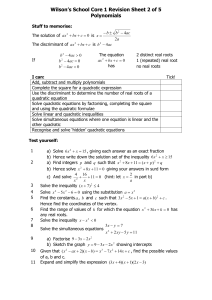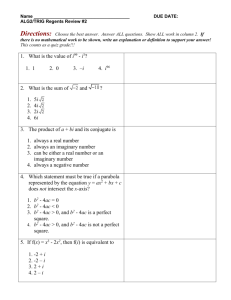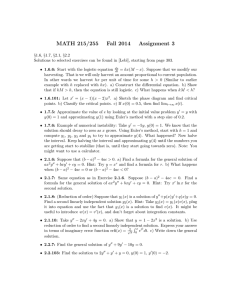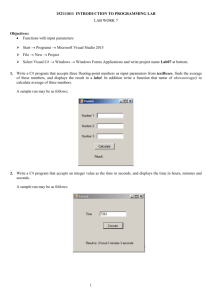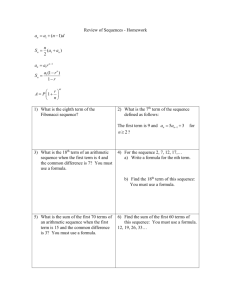SLCSE Math 1050, Spring, 2013
advertisement
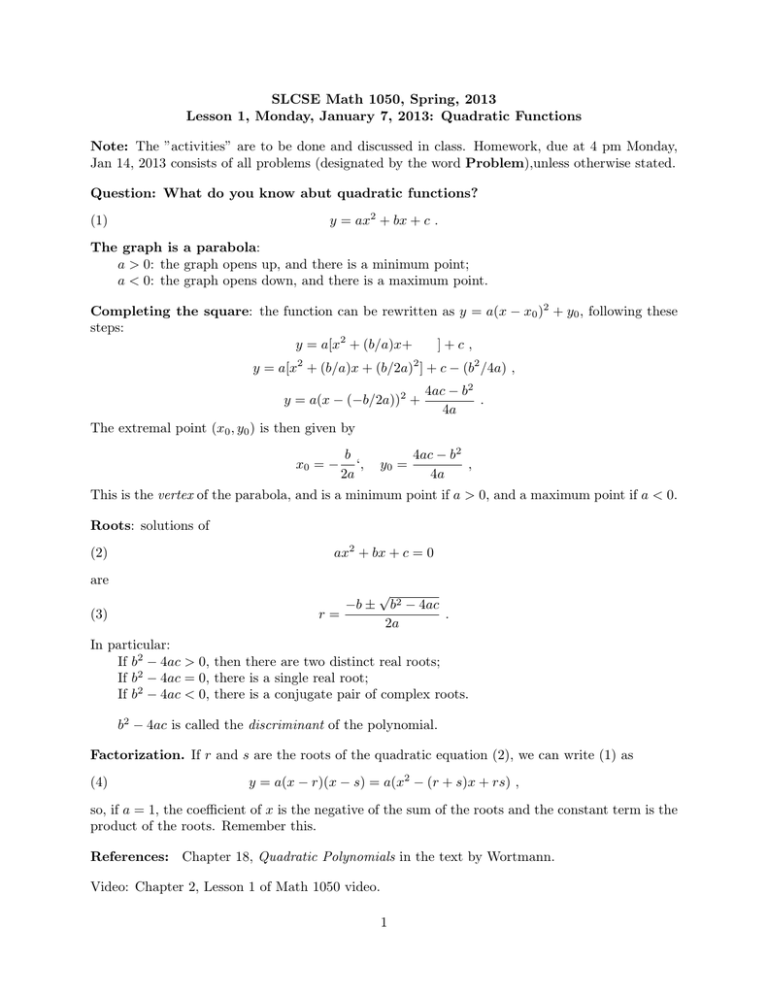
SLCSE Math 1050, Spring, 2013 Lesson 1, Monday, January 7, 2013: Quadratic Functions Note: The ”activities” are to be done and discussed in class. Homework, due at 4 pm Monday, Jan 14, 2013 consists of all problems (designated by the word Problem),unless otherwise stated. Question: What do you know abut quadratic functions? y = ax2 + bx + c . (1) The graph is a parabola: a > 0: the graph opens up, and there is a minimum point; a < 0: the graph opens down, and there is a maximum point. Completing the square: the function can be rewritten as y = a(x − x0 )2 + y0 , following these steps: y = a[x2 + (b/a)x+ ]+c , y = a[x2 + (b/a)x + (b/2a)2 ] + c − (b2 /4a) , y = a(x − (−b/2a))2 + 4ac − b2 . 4a The extremal point (x0 , y0 ) is then given by x0 = − b ‘, 2a y0 = 4ac − b2 , 4a This is the vertex of the parabola, and is a minimum point if a > 0, and a maximum point if a < 0. Roots: solutions of (2) ax2 + bx + c = 0 are (3) r= −b ± √ b2 − 4ac . 2a In particular: If b2 − 4ac > 0, then there are two distinct real roots; If b2 − 4ac = 0, there is a single real root; If b2 − 4ac < 0, there is a conjugate pair of complex roots. b2 − 4ac is called the discriminant of the polynomial. Factorization. If r and s are the roots of the quadratic equation (2), we can write (1) as (4) y = a(x − r)(x − s) = a(x2 − (r + s)x + rs) , so, if a = 1, the coefficient of x is the negative of the sum of the roots and the constant term is the product of the roots. Remember this. References: Chapter 18, Quadratic Polynomials in the text by Wortmann. Video: Chapter 2, Lesson 1 of Math 1050 video. 1 Optimization Problems Example. Farmer Brown intends to build a rectangular chicken coop with one wall made of brick, and the other three sides, of chain-link fence. The cost of a brick wall is $25/linear foot while that of chain link is $10/linear foot. He has $800 to spend on this project. What are the dimensions of the coop of maximum area that he can build? Let x and y be the dimensions (in linear feet) of the sides of the rectangle, so that the areas is A = xy. If we let x represent the dimension of the side that will be made of brick, he will have x + 2y linear feet of chain link, and x linear feet of brick. The cost will be 10(x + 2y) + 25x, and thus (since he will use all his money to achieve the maximum) we have the condition: (5) 10(x + 2y) + 25x = 800 . We can use this condition to solve for y in terms of x to get y= 7 800 − 35x = 40 − x , 20 4 and we want to maximize (6) 7 7 A = x 40 − x = − x2 + 40x . 4 4 SInce this is a quadratic function for which we seek the maximum, we need only find the vertex. Rewrite (6) as if to complete the square: A=− 7 2 160 x − x+ 4 7 , from which we read that the x coordinate of the vertex is 160/14 = 11.43, and the y coordinate is y = 40 − 7 160 = 20 . 4 14 These are the dimensions of the coop of maximum area. Problem 1. A commuter train carries 600 passengers each day from a suburb to a city. It costs $ 1.50 per person to ride the train. It is found that 40 more people will ride the train for each 5 cent decrease in the fare. What fare should be charged to make the largest possible revenue? Problem 2. An automobile maufacturer sells, on average, 8000 cars per month at twenty-five thousand dollars. The marketing department has determined that for every one thousand dollar reduction in price, the company can sell an additional 500 cars per month. At what price should the car be sold so as to maximize revenue? Problem 3. The Jones Jumpersuit Company can sell 400 − 8p jumpersuits each month at a price of 120 + p dollars. Jones has fixed costs of $ 8000 per month, and the cost in labor and material for each suit is $ 25. At what price will Jones maximize profit? Problem 4. Tickets for the Giulia Opera sell at $65 each. However, for groups, this deal is offered: for every 10 tickets over 100 purchased there will be a 2% discount on all tickets. Of course, as we 2 can see there has to be an upper limit: for a group of 600 people, the tickets will be free. Giulia decides to set a limit at that number which maximizes the total revenue. What is that number? Problem 5. a) Graph a) y = x + C/x for x positive. Notice that as x → 0 or x → ∞, y becomes infinite. b) Find the coordinates of the minimum point. Hint: Think quadratic equation. Problem 6 Find the dimensions of the right triangle with one vertex at the origin, another on the positive x-axis, and the third on the curve y = 4 + x−2 which is of minimum area. Problem 7. With the same data as that in the example, suppose instead that Farmer Brown wants to build a coop that encloses 200 sq. ft. What are the dimensions that minimize the cost? Arithmetic and geometric means Suppose, over a five year period, you receive raises in your salary at these increments: Year Increase 1 2 420 470 3 250 4 5 300 430 Problem 8. a) Suppose your starting salary was $10,000. What is your salary during each of the next 5 years? b) What is your average raise of the five year period; that is, what is the value of a single D such that a constant increment of $D each year results in the same end salary? Now suppose that instead you received percentage raises. For example, if you received a 4.2% raise after the first year, your new salary would be 10, 000 + (.042)(10, 000) = (1.042)(10, 000) = 10, 420 . Now, let’s say that in 5 years of work, you received these percentage raises: Year Percent 1 4.20 2 4.70 3 4 2.50 3.00 5 4.30 Problem 9. a) In this scenario, what is your salary during each of the next 5 years? b) Why is the answer not the same as the answer to Problem 8a? c) What is your average percentage raise of the five year period; that is, what is the value of a single r such that a constant percentage increase of r% each year results in the same end salary? d) Calculate the percentage increases, year by year in the first scenario. Why do these numbers differ from those of the above table? The difference here is that between an additive process and a multiplicative process. In an additive process, we start with a certain number A and add amounts d1 , d2 , d3 , . . . , dn over subsequent years. Our question is: what single addend d has the same effect over the n years. In a multiplicative process, we start with a certain number A and multiply by factors r1 , r2 , r3 , . . . , rn over subsequent years. Our question is: what single factor r has the same effect over the n years. 3 So we might have Period Add Multiply by 1 d1 r1 2 d2 r2 3 d3 d3 4 d4 r4 5 d5 r5 The average addend for the additive process is the arithmetic mean: d1 + d2 + d3 + d4 + d5 . d¯ = 5 Arithmetic mean : The average factor for the multiplicative process is the geometric mean: r̄ = (r1 · r2 · r3 · r4 · r5 )1/5 . Geometric mean : Let’s look at the arithmetic and geometric means for two positive numbers: AM = √ a+b 2 GM = ab . Problem 10. Show that AM ≥ GM with equality only if a = b. Hint. a and b are the real roots of the quadratic equation (x − a)(x − b) = 0. Now look at the discriminant condition for two real roots. Here is another proof. Start with the equation (4) (m + h)(m − h) = m2 − h2 . Problem 11. Can you find a geometric demonstration of this equation? Problem 12. Use (4) to show that GM < AM unless a = b. Hint. Suppose a < b. Let m = (a + b)/2 and h = m − a = b − m. Problem 13. Use the figure below to construct a geometric proof of (3). 4 Hint. In the large triangle on the right, the two triangles created by dropping the altitude are similar. Bigger Hint. The length of the altitude in the triangle on the left is the arithmetic mean of a and b. The inequality between the two means actually solves this geometric problem: Look at all rectangles of a given area. Find that rectangle with the minimum perimeter. Activity. Study examples to formulate an answer. To make the problem tractable: start with a rectangle of side lengths a and b. Then the perimeter is P = 2(a+b), and the area is A = ab. This involves the sum and the product of two real numbers, and so suggests quadratic equations. Observe that a and b are roots of the equation x2 − P x+A=0 . 2 Important Message.The following problems extend these results to the means of 3 numbers; you need not submit solutions for them, but if time allows, we’ll discuss. Problem 14. Use your knowledge of discriminants of quadratic equations to show that the square (when a = b) is the rectangle of area A with minimum perimeter. Let a1 , a2 , . . . , an be n positive numbers. Their arithmetic mean is defined to be (5) AM = 1 (a1 + a2 + · · · + an ) n 5 and the geometric mean is defined to be (6) GM = a1 · a2 · · · an )1/n . It is a fact that the inequality (7) GM < AM , holds in this more general context, with equality if and only if the numbers are all the same. Let’s verify this with three numbers. Problem 15. Show that the rectangular parallelipiped of given volume that minimizes the total edge length (the sum of the lengths of its edges) is the cube. This is the isoperimetric principle in 3 dimensions. Hint. Suppose R is the rectangle that minimizes the total edge length. Let a, b, c be the dimensions of R. Suppose that R is not a cube, in particular that a 6= b. Then the square of area ab has shorter perimeter. Now, replace the a, b face of R with that square, obtaining a new rectangle of the same volume as R but shorter total edge length. Problem 16. Deduce the 3 number means inequality from the 3 dimensional isoperimetric principle. Hint. Let a, b, c be three positive numbers, and R the rectangular parallelipiped of those dimensions. The volume of R is abc and the total edge length is 4(a + b + c). Now what is the length of the side of the cube with the same volume, and what is its total edge length? 6
